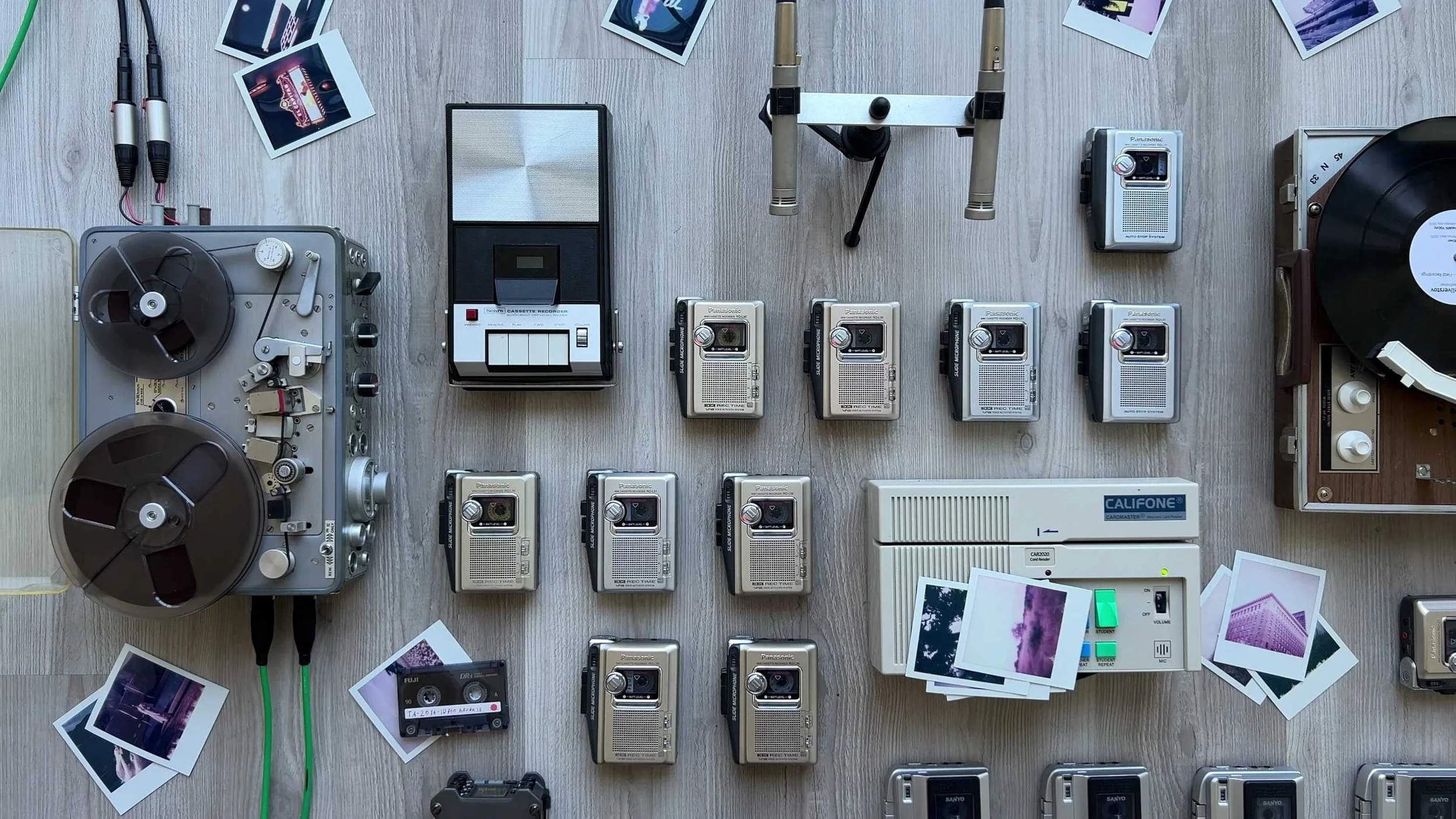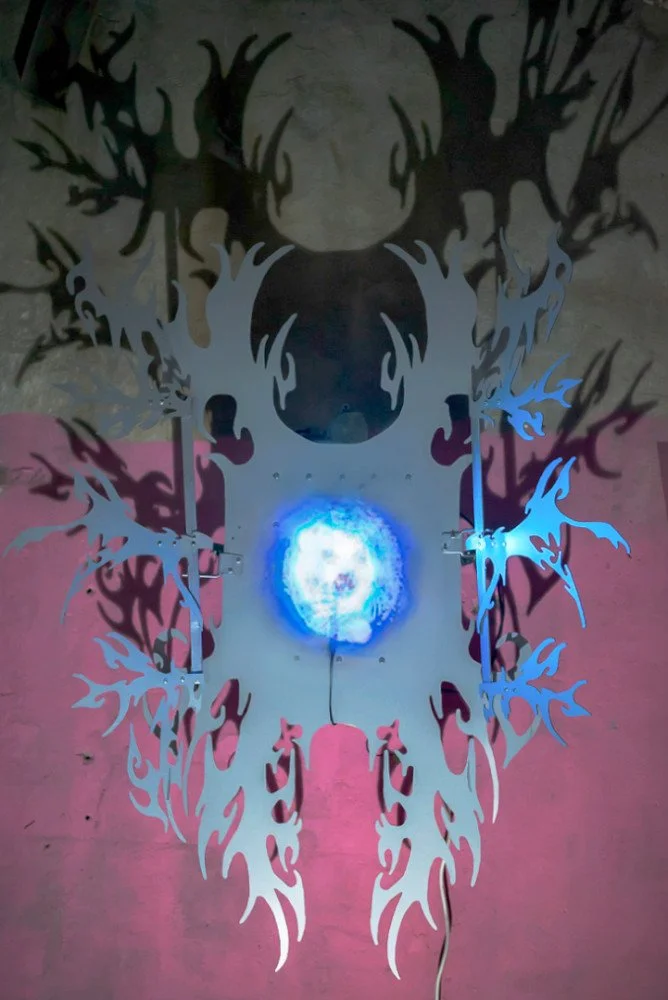Splinterframe
In an age that worships flawlessness, Cameron, known in the digital underground as Splinterframe, embraces the sacred rupture. His work does not seek to correct, it seeks to remember. Memory, like emotion, is often erratic. So are his visuals: audio-reactive sculptures of light and code, crafted not for virality but for resonance.
With a background in jazz theory and a tactile love for drum kits and circuitry, Cameron emerged from Denver’s avant-garde music scene not as an entertainer but as a poet of glitch. The emotional core of his work lies in its refusal to conform. Imperfection is not failure—it is fidelity to life. Drawing deeply from Japanese Kintsukuroi, Splinterframe’s ethos values brokenness not as a defect but as a site of golden restoration.
His installations unfold like open-ended questions—simultaneously ephemeral and immersive. They speak not of spectacle, but of solitude, city geometry, and the quiet chaos of human feeling. For Chameron, technology is merely a brush; the art lives in how the soul moves through it. These aren’t just images. They are offerings, anomalies, and unclaimed frequencies echoing through the architectures we inhabit—both digital and emotional.
Can you discuss the role of imperfection, emotions and randomness in your art? How do these elements contribute to the authenticity of your pieces?
I am very interested in the idea of Kintsukuroi- a traditional Japanese art form of repairing broken pottery with gold. Integrity to the narrative, despite imperfection and mistakes, is the beauty. Arguably, my biggest inspiration is that I love being human; aside from a few transcendentally inspired or narrative pieces, most of my work is inspired by slice-of-life aesthetics from my own day-to-day experiences.
How did this all start for you? What is your academic background? Mind disclosing your identity?
I studied jazz theory on keyboard, drum kit, and computer and spent about 3 years in Denver, Colorado, pursuing a relatively successful avant-garde music project. At my day job, I am an audio and video engineer for live events - a lot of my technical expertise and inspirations come directly from hardware setups, and especially errors. I got into TouchDesigner programming in March 2024 as a response to new media artists like Nouses Kou, Yoshi Sodeoka, and Baojiaxiang.
How do you address concerns about originality and authorship in an era where AI can replicate artistic styles?
AI - it’s quite the buzzword, isn’t it? I prefer that my style not be commodified, and I’m not sure if that’s an AI or a human thing. I start to think- What is worse? To be ‘found out’ and put into a formula by a computer program? Or to be idolised , imitated, and dissociated from my fellow human? After all, our survival instincts scream at us to avoid pattern recognition.
But our survival instincts are also what lead us to build families, communities, and societies. What is more perilous - to be alone or to be predictable? When an audience is attached to the glory and aesthetics of a fellow man, all while the poetry is forgotten, what does that mean for the art? AI is not a common anxiety for me, because my expression is about me, not a particular form of replicable VFX.
Anyone on the planet with a computer could do what I do. Yes, I suppose my VFX is somewhat ‘technologically’ unique, but it’s not where the art really is in my work, it lives in the technique itself. The real anxiety I have about commodification is a culture that gives dogma to a cutthroat fiscal ideology where desperate people are given easy access to sap gold from blood.
Describe your process for selecting or creating soundscapes that complement your visual work.
In my heart, I am a musician first. I often start an idea in Ableton(my music software) and route the audio into TouchDesigner (my multimedia software) to give audio-reactive movements in my video work. I continue to develop the moment by going back and forth between the two software until it’s 80-90% finished, then I finish editing using programs like After Effects Scripts, Davinci Resolve, various glitch plugins, etc..
Your installations often interact with the spaces they inhabit. How does architectural context influence your design choices?
I grew up skateboarding with a strong math+science brain- I love love love architecture. I bring up skateboarding because I learned a lot about style and design by exploring and performing in the urban jungle the way I did. No one, not even skaters, wants to watch a difficult skateboarding trick sort of just.. happen, in a suburban garage.
But, a stylishly done, much easier trick is appreciated by everyone, especially when done in a beautiful city with beautiful camera angles that showcase the rugged beauty of industrialised infrastructure. Architectural context in installations reminds me of skateboarding in this way.
One must first find an interesting spot to do a trick, then choose the right trick that is both original and interesting, and finally perform the trick with style, so that it’s truly a contribution to and celebration of skateboarding culture. I approach installation work exactly like this, asking myself, ‘How can I actually contribute to the culture in this moment of history? How do I pull this off with style?’.
In the age of social media, how do you balance the desire for digital visibility with the integrity of your artistic vision?
An interesting question that is nearly impossible to answer. This is likely my biggest dilemma right now. I will say that, for the most part, I feel that my released art is a sort of offering to humankind, a ‘karmic good’ that I am screaming into the void. This is what becomes difficult when thinking about views. The work is genuinely intended to uplift people.
I have become quite frustrated with this culture that treats ‘the algorithm’ as God. I am torn in a situation that is both a blessing and a curse; this same frustrating ‘algorithm’ has rewarded me for so much of my work, and I truly am mindblown where I am today. But at the same time, of course, I experience frustration for my audience when this ‘algorithm’ simply does not show the majority of my posts to the majority of my followers, these are people clearly asking the platform to show them my work.
I make these posts as love notes to humanity. Why do we give these platforms and their ‘algorithms’ so much power to be ‘God’-like, while they clearly manipulate intimate human relations? It is not God to silence messages of love and hope for those asking for them.
Looking ahead, what emerging technologies or cultural movements are you most excited to explore in your future projects?
The current media situation, especially in the USA, where I currently live, is... fascinating. The very nature and authority of information are in question. I foresee, and very much look forward to, an inevitable cultural revolution regarding the nature of truth and knowledge. I use quite a bit of data analysis structures and techniques in my work; it is very exciting to witness such progress and evolution in our understanding of quantified data while we go through so much upheaval on qualified data in linguistics, especially LLMs and media….
As far as emerging technology, I’m realistically pretty old school, I’m more of an artist than anything. For me, it’s about poetry and humanity more than it is about formulating new math. The clearest pattern I see in history is that the people who really take technology to the next level are usually the ones who are finding new use cases and applications for technology that’s been well-established for a long time. There is something about technology that can be so removed from humanity, I believe it does require both mathematicians and poets to introduce actually effective technology. I see myself as one of those poets with a defined respect and keen interest in mathematics.
Interview by JAGRATI MAHAVER
What to read next






